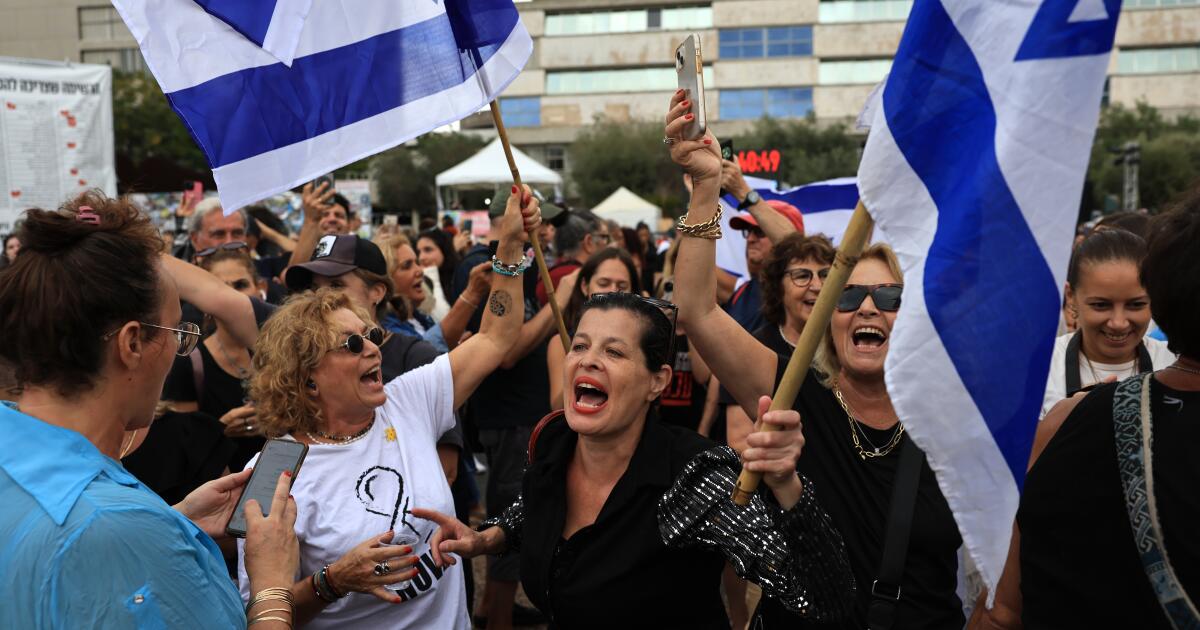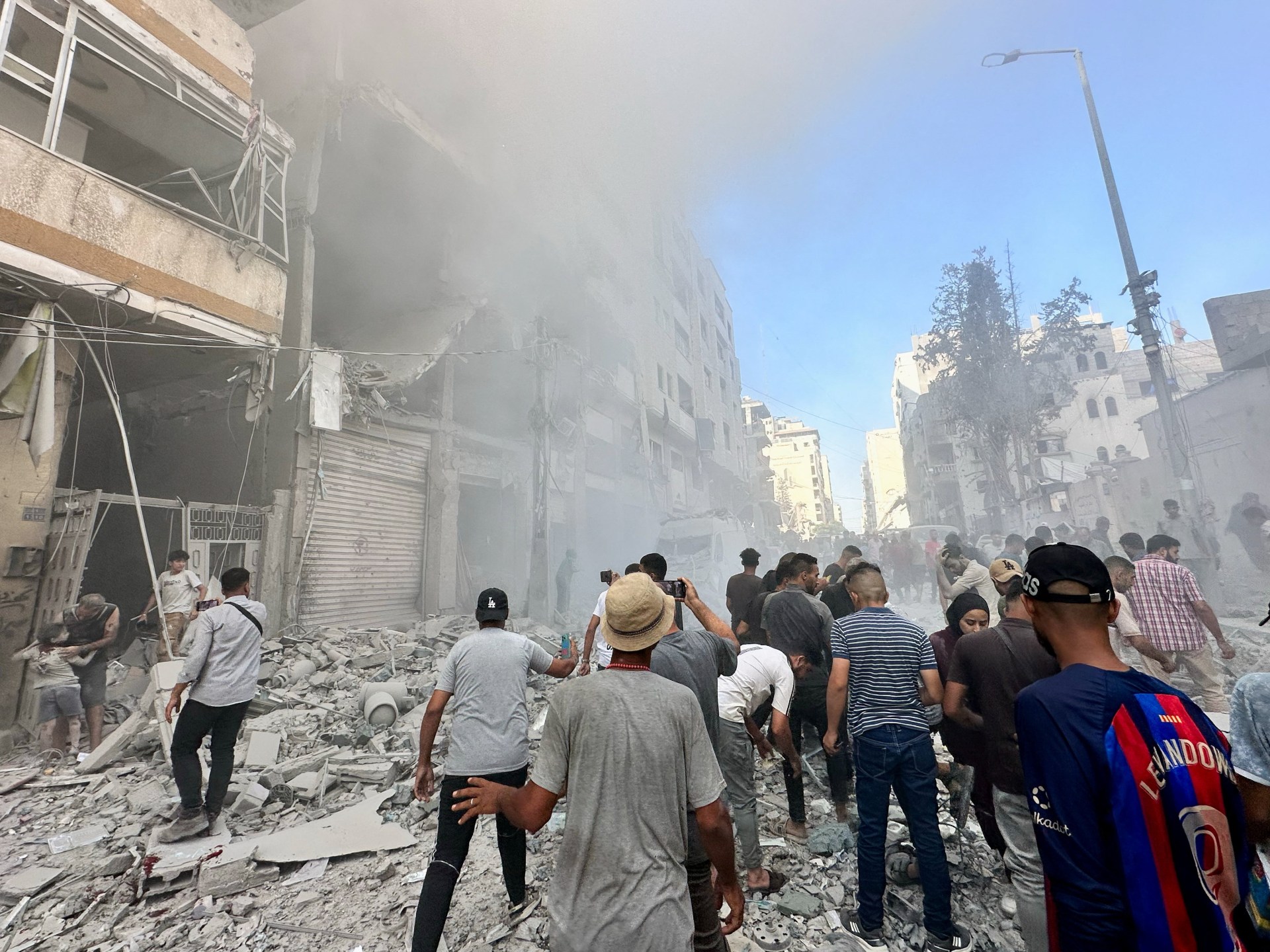Celebrations erupt over Israel-Hamas ceasefire in Gaza
TEL AVIV — After two years of devastating war that killed tens of thousands, left millions displaced and pulverized much of Gaza into an apocalyptic moonscape, Israel and Hamas have agreed to the first phase of a deal involving an exchange of Israeli hostages and Palestinian detainees.
Though Israel had still not formally ratified the pact, it was expected to do so Thursday evening, and celebrations had already broken out in the country. The news was greeted with relief and joy in Gaza, where Hamas said the agreement would end the war and lead to Israel’s full withdrawal from the enclave and to the entry of desperately needed aid.
The deal caps months of torturous ceasefire negotiations and delivers a denouement to a generation-defining fight in the Israeli-Palestinian conflict.
Posting on his social media platform Truth Social on Wednesday, President Trump announced the two sides had signed off on “the first Phase of our Peace Plan,” which would involve the hostage-detainee swap along with the Israeli military’s withdrawal from parts of Gaza — “the first steps towards a Strong, durable, and Everlasting Peace,” according to Trump.
“BLESSED ARE THE PEACEMAKERS,” he wrote.
News of the agreement triggered celebrations across Gaza, with residents exhausted by Israel’s no-holds-barred assault that had upended their lives, erased entire families and brought famine to the enclave expressing cautious hope.
“I never thought I’d see this day. We’ve been wanting it to come for months now, and then suddenly it happened so fast,” said Ali al-Azab, 34, from the central city of Deir Al-Balah in the enclave.
“We’ve been living in fear for so long, waiting for the next bomb to come, to lose another friend. But I also know the war isn’t over yet.”
Word of the ceasefire came early Thursday morning in Gaza, as Mohammad Rajab, 62, was still asleep. His son-in-law, he said, was the first to hear the good news.
“We’re like drowning people clutching at straws,” he said, adding that the ceasefire meant for him the chance “to return to a normal life.”
In Tel Aviv’s so-called Hostage Square, the area of this coastal city that has become the de-facto gathering point for Israelis’ large-scale protests to end the war and bring the hostages home, the mood Thursday was jubilant, with people dancing as they waved Israeli and American flags.
Many sported stickers on their shirts with the words “They’re returning,” in reference to the hostages, replacing stickers that had before depicted the number of days they had spent in captivity. At one point, a man blew a shofar, the traditional musical horn used in Jewish rituals, to the crowd’s applause.
Udi Goren, 44, a travel photographer whose cousin, 44-year-old Tal Haimi, was killed on Oct. 7, 2023, and taken to Gaza, said his “first instinct was a sigh of relief.”
“For the first morning in two years, we can actually have a true smile because we finally see the end: The end of the war, of fallen soldiers, of hostages being tortured and starved, of the horrific sights from Gaza.”
He credited Trump for pressuring the belligerents to get the deal done.
“There was no real intervention until what we’ve just seen with President Trump finally saying enough is enough,” he said.
The deal, which is more of a framework centered on a 20-point plan Trump released last week, would see all 48 hostages — 20 of them alive, the rest deceased — released. Hamas officials have said in recent interviews that retrieving bodies of dead hostages will take time, as many are in collapsed or bombed-out tunnels or under the rubble. Those alive could be released as early as Sunday or Monday.
Israel will release 1,700 Gaza residents detained during the war, along with 250 Palestinian prisoners serving life sentences in Israel. For every Israeli body returned, Israel will release the bodies of 15 Gaza residents.
Hamas said on Thursday it had handed over the list of prisoners to be released to mediators, and would announce the names once they were agreed upon.
Earlier reports claimed the ceasefire had already begun, but Israeli airstrikes and artillery still continued to pound the enclave Thursday, with health authorities in the enclave saying at least 10 people were killed and dozens injured.
Footage taken by Qatari broadcaster Al Jazeera depicted tanks shelling Gaza’s main coastal road to prevent Palestinians from gathering in the area. Civil defense crews warned people attempting to return to the north of the enclave from doing so they received confirmation Israeli forces had left.
In a statement to Israeli daily Times of Israel, the office of Israeli Prime Minister Benjamin Netanyahu said the ceasefire would begin Thursday evening after the government officially ratifies the agreement. The government is set to vote on the agreement at 6 p.m. local time, according to Israeli media.
The Israeli military said in a statement it had “begun operational preparations ahead of the implementation of the agreement” and would adjust deployment lines “soon.” Meanwhile, it was still “deployed in the area,” it said, and the military’s Arabic-language spokesman said in a statement that Gaza City was still surrounded by the army and that returning to it was dangerous.
The ceasefire will be accompanied by a surge of aid into the enclave, a crucial component of the agreement meant to alleviate a crushing, months-long Israeli blockade that had triggered famine in parts of the enclave, according to aid groups and experts. Aid groups and the Palestinian Health Ministry said more than 400 people had died of starvation in recent months.
Writing on X, Cindy McCain, executive director of the World Food Program, said the group was “on the ground and ready to scale up operations.”
“But we need to move NOW — there is no time to waste,” she wrote.
The war began on Oct. 7, 2023, when Hamas militants blitzed into southern Israel, leaving 1,200 people — two thirds of them civilians, according to Israeli authorities — and kidnapping some 250 others.
In retaliation, Israel launched a furious response that has so far killed 67,183 people, encompassing more than 3% of the enclave’s population and including 20,179 children, the Palestinian Health Ministry says. Though it does not distinguish between civilians and fighters, its figures are seen as reliable.
Yet much remains unclear, including the fate of Hamas’s arsenal and what sort of presence, if at all, Israel will maintain in the enclave.
Speaking to the Qatari channel Al-Araby TV, Hamas official Osama Hamdan said Israel would pull out militarily from all populated areas in Gaza — including Khan Yunis, Rafah, and Gaza City by Friday. Another spokesman, Hazem Qassem, said in an interview with Al Jazeera on Thursday the group will not be part of Gaza’s governance in the future. but that the group’s arms were to “guarantee the independence of Palestinian decision-making.”
Other Hamas officials have said handing over weapons would only occur as part of a move towards an independent Palestinian state.
Despite Trump’s rhetoric, the agreement remains far from the comprehensive peace agreement he has promised. And its success kicks up thornier questions for Netanyahu, a deeply unpopular leader with many Israelis and whose critics accuse of prolonging the war to guarantee his political survival at the expense of hostages’ lives.
Implementing the agreement is likely to alienate his right-wing allies in the government, including extremist figures such as Israeli Finance Minister Bezalel Smotrich, who has called for Gaza to be emptied of Palestinians. He said in a statement on X that he will vote against the deal.
He added the government had “an enormous obligation to ensure that we do not return to the Oslo track,” referring to the Oslo peace process, and to becoming “addicted again to artificial calm, diplomatic embraces, and smiling ceremonies, while mortgaging the future and paying horrific prices.”
At Hostage Square, Israelis demonstrated their rage at Netanyahu and others associated with his leadership during the war. When Benny Gantz, an Israeli opposition leader who served in Netanyahu’s cabinet until last year walked through the crowd, hecklers shouted at him “to go home,” accusing him of claiming a success he had not earned.
“When the war began, Gantz joined Bibi and saved him instead of bringing down his government,” said Einat Mastbaum, a 50-year-old Hebrew teacher, employing Netanyahu’s nickname.
Yet even politicians’ presence couldn’t detract from the happiness of the crowd, according to Mastbaum, who has been coming to Hostage Square every week for the last two years.
“I’m so excited,” she said, her voice cracking as tears appeared in her eyes.
“Today I’m crying from happiness and hope, not sadness.”
Times Staff Writer Bulos reported from Tel Aviv. Special correspondent Bilal Shbeir contributed from Al-Balah, Gaza Strip.

